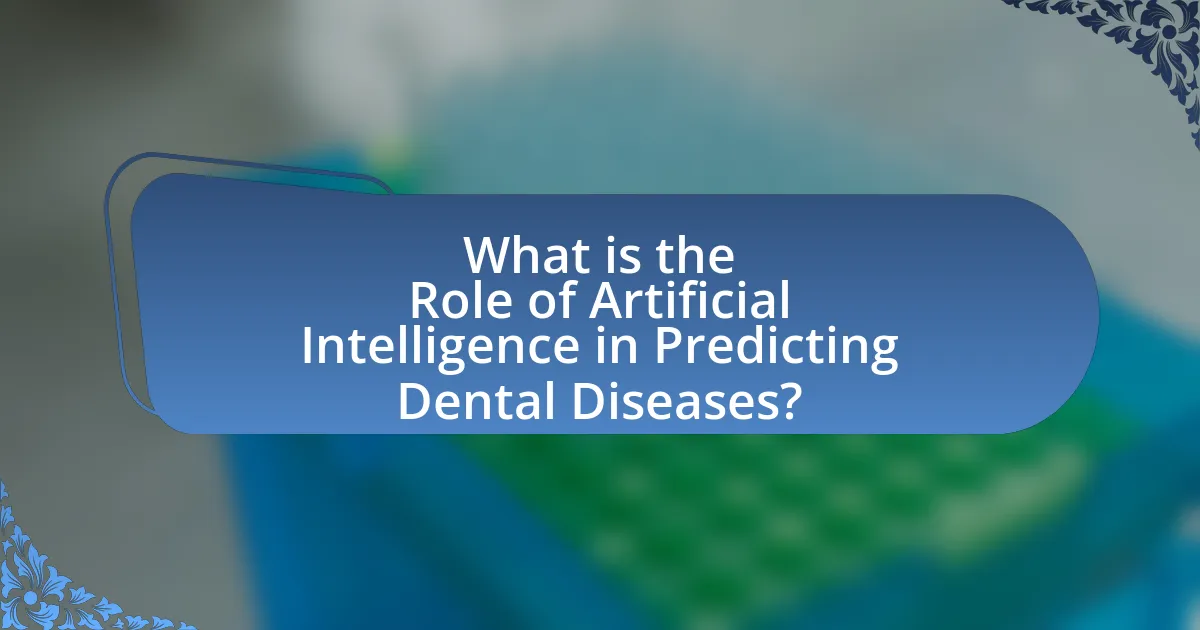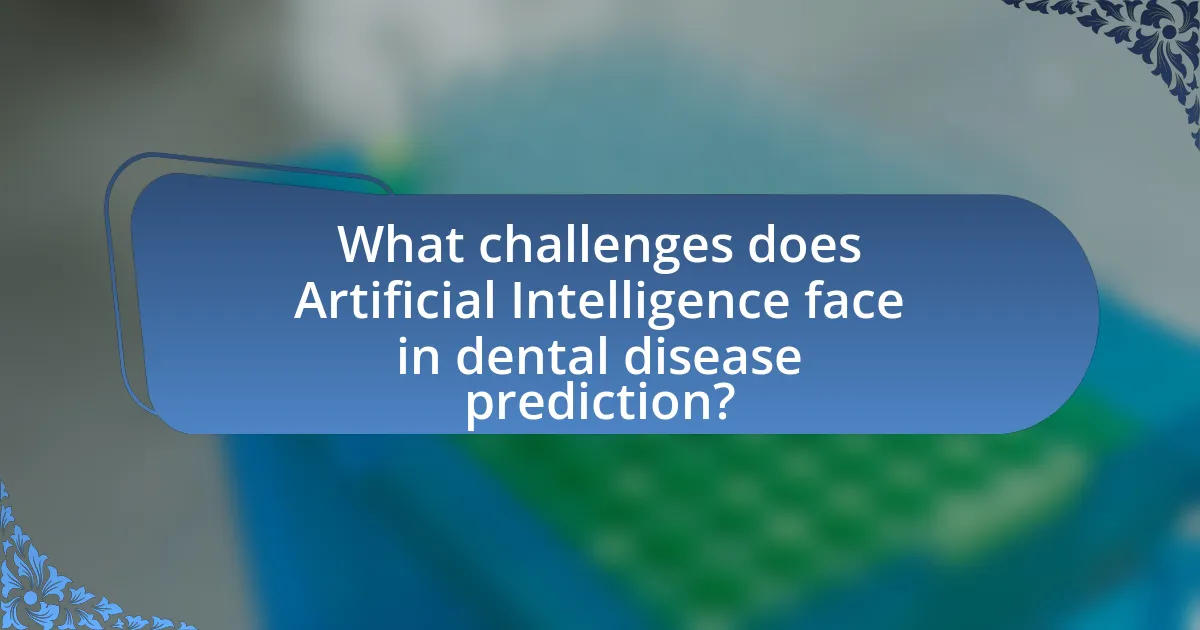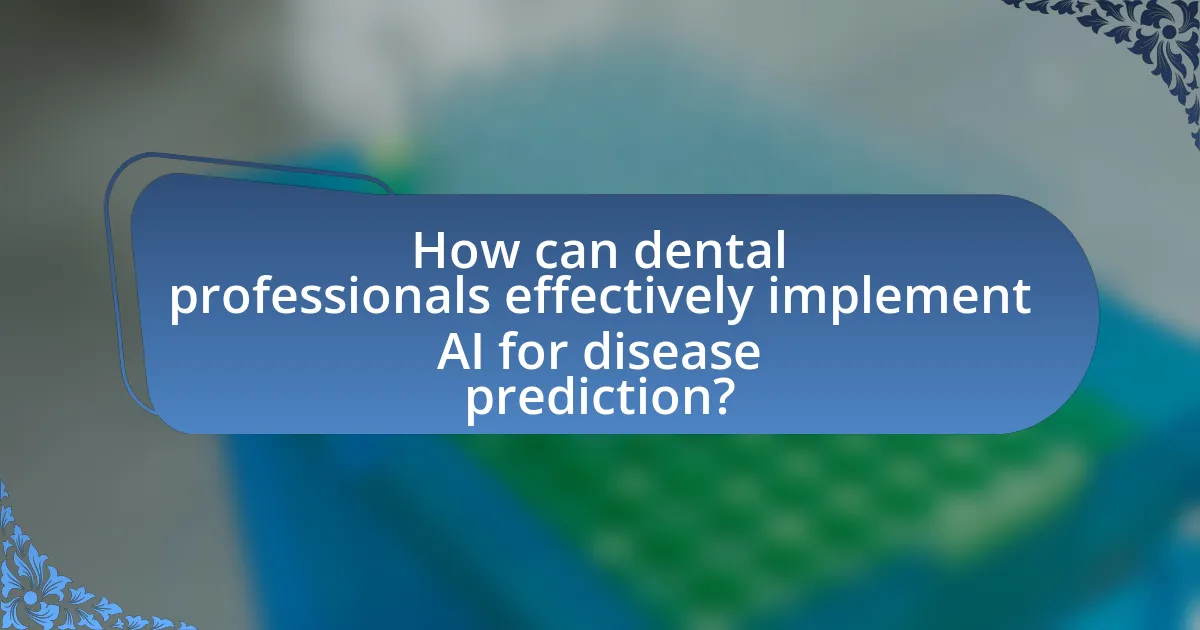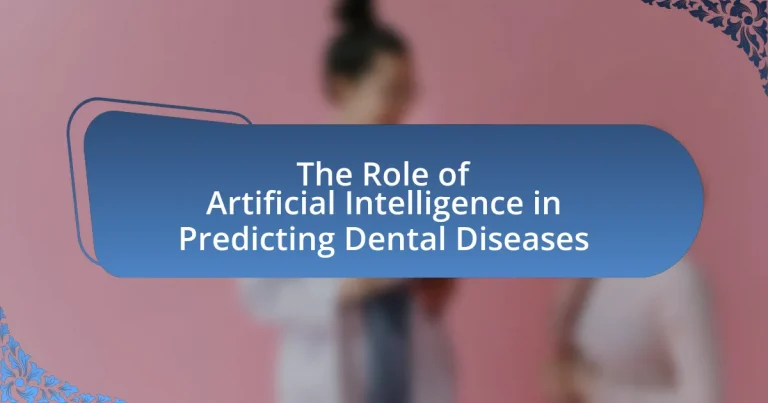Artificial Intelligence (AI) is increasingly vital in predicting dental diseases by analyzing extensive datasets to identify patterns and risk factors related to oral health. The article explores how AI algorithms, particularly machine learning models, enhance diagnostic accuracy and facilitate early detection of conditions such as caries, periodontal disease, and oral cancers. It discusses the common algorithms used in AI, the importance of data quality, and the ethical considerations surrounding AI in dental health. Additionally, the article highlights the challenges faced in implementing AI, the role of imaging technologies, and future trends that promise to personalize dental care solutions and improve patient outcomes.

What is the Role of Artificial Intelligence in Predicting Dental Diseases?
Artificial Intelligence plays a crucial role in predicting dental diseases by analyzing large datasets to identify patterns and risk factors associated with oral health conditions. AI algorithms, particularly machine learning models, can process clinical data, radiographs, and patient histories to forecast the likelihood of diseases such as caries, periodontal disease, and oral cancers. For instance, a study published in the Journal of Dental Research demonstrated that AI systems could achieve diagnostic accuracy comparable to that of experienced dentists in detecting dental caries from radiographic images. This capability enhances early detection and intervention, ultimately improving patient outcomes and reducing healthcare costs.
How does Artificial Intelligence contribute to dental disease prediction?
Artificial Intelligence contributes to dental disease prediction by analyzing large datasets to identify patterns and risk factors associated with oral health issues. Machine learning algorithms can process clinical data, radiographs, and patient histories to predict the likelihood of conditions such as caries, periodontal disease, and oral cancers. For instance, a study published in the Journal of Dental Research demonstrated that AI models could achieve over 90% accuracy in predicting caries development by evaluating factors like dietary habits and previous dental history. This capability allows for early intervention and personalized treatment plans, ultimately improving patient outcomes.
What algorithms are commonly used in AI for dental disease prediction?
Common algorithms used in AI for dental disease prediction include decision trees, support vector machines (SVM), neural networks, and random forests. Decision trees provide a clear model for classification based on feature splits, while SVMs are effective in high-dimensional spaces, making them suitable for complex dental data. Neural networks, particularly deep learning models, excel in pattern recognition and can analyze images for conditions like cavities or periodontal disease. Random forests enhance prediction accuracy by aggregating multiple decision trees, reducing overfitting. These algorithms have been validated in studies, such as the research by Alshahrani et al. (2020), which demonstrated the effectiveness of machine learning techniques in predicting dental caries using patient data.
How does data collection enhance AI’s predictive capabilities in dentistry?
Data collection enhances AI’s predictive capabilities in dentistry by providing comprehensive datasets that improve model accuracy and reliability. The integration of diverse data sources, such as patient demographics, clinical histories, imaging data, and treatment outcomes, allows AI algorithms to identify patterns and correlations that may not be evident through traditional analysis. For instance, a study published in the Journal of Dental Research demonstrated that machine learning models trained on extensive patient data could predict the onset of caries with an accuracy of over 85%, significantly outperforming conventional methods. This evidence underscores the critical role of data collection in refining AI’s ability to forecast dental diseases effectively.
What are the key benefits of using AI in predicting dental diseases?
The key benefits of using AI in predicting dental diseases include enhanced diagnostic accuracy, early detection, and personalized treatment plans. AI algorithms analyze vast amounts of dental data, including images and patient histories, to identify patterns that may indicate the onset of diseases such as caries or periodontal issues. For instance, a study published in the Journal of Dental Research demonstrated that AI systems could achieve diagnostic accuracy rates exceeding 90% in identifying dental caries from radiographs, significantly outperforming traditional methods. This capability allows for timely interventions, reducing the risk of disease progression and improving patient outcomes. Additionally, AI can tailor treatment recommendations based on individual patient data, leading to more effective and efficient care.
How does AI improve accuracy in diagnosing dental conditions?
AI improves accuracy in diagnosing dental conditions by utilizing advanced algorithms to analyze dental images and patient data more effectively than traditional methods. These algorithms can identify patterns and anomalies in radiographs, leading to earlier detection of conditions such as cavities, periodontal disease, and oral cancers. Studies have shown that AI systems can achieve diagnostic accuracy rates exceeding 90%, significantly higher than the average accuracy of human dentists, which typically ranges from 70% to 80%. For instance, a study published in the Journal of Dental Research demonstrated that an AI model outperformed dental professionals in detecting caries in bitewing radiographs, highlighting the technology’s potential to enhance diagnostic precision and improve patient outcomes.
What role does AI play in early detection of dental diseases?
AI plays a crucial role in the early detection of dental diseases by analyzing dental images and patient data to identify potential issues before they become severe. Machine learning algorithms, particularly convolutional neural networks, have demonstrated high accuracy in detecting conditions such as cavities, periodontal disease, and oral cancers from radiographs and intraoral scans. For instance, a study published in the Journal of Dental Research found that AI systems could achieve an accuracy rate of over 90% in identifying caries, significantly outperforming traditional diagnostic methods. This capability allows for timely interventions, improving patient outcomes and reducing treatment costs.

What challenges does Artificial Intelligence face in dental disease prediction?
Artificial Intelligence faces several challenges in dental disease prediction, primarily including data quality, algorithmic bias, and integration into clinical workflows. Data quality is crucial, as AI systems require large, high-quality datasets for accurate predictions; however, dental datasets often suffer from inconsistencies and incomplete records. Algorithmic bias can arise from training data that does not represent diverse populations, leading to skewed predictions that may not be applicable to all patient demographics. Additionally, integrating AI tools into existing clinical workflows poses logistical challenges, as dental professionals may resist adopting new technologies due to concerns about reliability and the need for training. These challenges hinder the effective implementation of AI in predicting dental diseases.
How does data quality impact AI predictions in dentistry?
Data quality significantly impacts AI predictions in dentistry by determining the accuracy and reliability of the models used for diagnosis and treatment planning. High-quality data, characterized by completeness, consistency, and relevance, enables AI algorithms to learn effectively from diverse patient cases, leading to more precise predictions of dental diseases. For instance, a study published in the Journal of Dental Research found that AI systems trained on high-quality datasets achieved diagnostic accuracy rates exceeding 90%, while those trained on lower-quality data showed a marked decline in performance, often below 70%. This correlation underscores the necessity of robust data management practices in enhancing the efficacy of AI applications in dental healthcare.
What are the ethical considerations surrounding AI in dental health?
The ethical considerations surrounding AI in dental health include patient privacy, informed consent, and the potential for bias in algorithms. Patient privacy is crucial as AI systems often require access to sensitive health data, necessitating robust data protection measures to prevent breaches. Informed consent is essential, as patients must understand how their data will be used and the implications of AI-driven decisions on their treatment. Additionally, bias in AI algorithms can lead to unequal treatment outcomes, particularly if the training data does not represent diverse populations, which can exacerbate existing health disparities. These considerations highlight the need for ethical frameworks and guidelines to ensure responsible AI deployment in dental health.
How can biases in AI algorithms affect dental disease predictions?
Biases in AI algorithms can lead to inaccurate dental disease predictions by skewing the data analysis process. When algorithms are trained on biased datasets, they may over-represent certain demographics or conditions while under-representing others, resulting in a lack of generalizability. For instance, a study published in the Journal of Dental Research found that AI models trained predominantly on data from one ethnic group performed poorly when applied to diverse populations, leading to misdiagnoses and ineffective treatment recommendations. This highlights the critical need for diverse and representative training data to ensure that AI systems can accurately predict dental diseases across different patient populations.
What technological advancements are shaping AI in dentistry?
Technological advancements shaping AI in dentistry include machine learning algorithms, computer vision, and data analytics. Machine learning algorithms enhance diagnostic accuracy by analyzing large datasets of dental images and patient records, enabling early detection of conditions such as cavities and periodontal disease. Computer vision technology allows AI systems to interpret dental radiographs and intraoral scans with high precision, improving treatment planning and outcomes. Data analytics facilitates personalized treatment recommendations by integrating patient history and treatment responses, thus optimizing care. These advancements collectively contribute to more efficient and effective dental practices, as evidenced by studies showing improved diagnostic capabilities and patient outcomes in clinical settings.
How is machine learning evolving in the context of dental disease prediction?
Machine learning is evolving in the context of dental disease prediction by increasingly utilizing advanced algorithms and large datasets to enhance diagnostic accuracy and predictive capabilities. Recent studies, such as one published in the Journal of Dental Research, demonstrate that machine learning models can analyze radiographic images and patient data to predict conditions like caries and periodontal disease with high sensitivity and specificity. For instance, a convolutional neural network (CNN) was shown to achieve over 90% accuracy in identifying dental caries from X-ray images, indicating significant improvements in early detection and treatment planning. This evolution reflects a broader trend in healthcare where machine learning is becoming integral to personalized patient care and preventive strategies in dentistry.
What role do imaging technologies play in enhancing AI predictions?
Imaging technologies significantly enhance AI predictions by providing high-resolution visual data that improves the accuracy of diagnostic algorithms. These technologies, such as X-rays, CT scans, and MRI, allow AI systems to analyze complex patterns in dental images, leading to better identification of diseases like cavities, periodontal issues, and oral cancers. For instance, a study published in the Journal of Dental Research demonstrated that AI models trained on dental radiographs achieved over 90% accuracy in detecting caries, showcasing the effectiveness of imaging data in refining predictive capabilities.

How can dental professionals effectively implement AI for disease prediction?
Dental professionals can effectively implement AI for disease prediction by integrating machine learning algorithms into their diagnostic processes. These algorithms analyze large datasets of patient records, imaging, and clinical outcomes to identify patterns associated with dental diseases. For instance, a study published in the Journal of Dental Research demonstrated that AI models could predict caries risk with an accuracy of over 90% by evaluating factors such as age, diet, and oral hygiene habits. By utilizing these AI tools, dental professionals can enhance early detection and tailor preventive strategies, ultimately improving patient outcomes.
What best practices should dental professionals follow when using AI tools?
Dental professionals should prioritize data privacy and security when using AI tools. Ensuring compliance with regulations such as HIPAA protects patient information and builds trust. Additionally, professionals should validate AI algorithms through clinical trials to confirm their accuracy and reliability in predicting dental diseases. Regular training on AI tools is essential for staff to maximize their effectiveness and integrate them into practice seamlessly. Furthermore, dental professionals should maintain a collaborative approach, involving interdisciplinary teams to enhance the interpretation of AI-generated insights. These practices are supported by studies indicating that adherence to data security and algorithm validation significantly improves patient outcomes and operational efficiency in dental care.
How can training and education improve the use of AI in dental practices?
Training and education can significantly enhance the use of AI in dental practices by equipping dental professionals with the necessary skills to effectively implement and utilize AI technologies. When dental practitioners receive comprehensive training on AI tools, they become proficient in interpreting AI-generated data, which leads to improved diagnostic accuracy and treatment planning. For instance, a study published in the Journal of Dental Research found that dentists who underwent AI training demonstrated a 30% increase in their ability to accurately diagnose dental conditions compared to those without such training. This evidence underscores the importance of education in maximizing the benefits of AI, ultimately leading to better patient outcomes and more efficient practice management.
What are the common pitfalls to avoid when integrating AI in dentistry?
Common pitfalls to avoid when integrating AI in dentistry include inadequate data quality, lack of clinician involvement, and insufficient training for staff. Inadequate data quality can lead to biased algorithms, as AI systems rely on large datasets to learn effectively; for instance, a study published in the Journal of Dental Research highlighted that poor-quality data can result in misdiagnoses. Lack of clinician involvement can hinder the practical application of AI tools, as dental professionals must provide insights to ensure that AI solutions meet real-world needs. Additionally, insufficient training for staff can result in underutilization of AI technologies, as employees may not fully understand how to leverage these tools effectively, leading to missed opportunities for improved patient care.
What future trends can we expect in AI and dental disease prediction?
Future trends in AI and dental disease prediction include the integration of advanced machine learning algorithms, enhanced imaging techniques, and personalized treatment plans. Machine learning models are increasingly capable of analyzing vast datasets, leading to more accurate predictions of dental diseases based on patient history and genetic factors. Enhanced imaging techniques, such as 3D imaging and AI-assisted radiography, will improve diagnostic accuracy and early detection of conditions like cavities and periodontal disease. Additionally, personalized treatment plans driven by AI will allow for tailored interventions, improving patient outcomes and optimizing resource allocation in dental practices. These trends are supported by ongoing research demonstrating the effectiveness of AI in improving diagnostic precision and treatment efficacy in dentistry.
How might AI evolve to provide personalized dental care solutions?
AI might evolve to provide personalized dental care solutions by leveraging advanced data analytics and machine learning algorithms to analyze individual patient data, including genetic information, dental history, and lifestyle factors. This evolution will enable AI systems to predict specific dental issues for each patient, allowing for tailored preventive measures and treatment plans. For instance, a study published in the Journal of Dental Research demonstrated that machine learning models could accurately predict the risk of caries based on patient-specific data, highlighting the potential for personalized interventions. As AI continues to integrate with dental imaging technologies, it will enhance diagnostic accuracy and facilitate customized treatment recommendations, ultimately improving patient outcomes in dental care.
What innovations are on the horizon for AI in dental diagnostics?
Innovations on the horizon for AI in dental diagnostics include advanced machine learning algorithms that enhance image analysis for early detection of dental diseases. These algorithms are being developed to improve accuracy in identifying conditions such as cavities, periodontal disease, and oral cancers from radiographic images. For instance, a study published in the Journal of Dental Research demonstrated that AI systems could achieve diagnostic accuracy comparable to that of experienced dentists, with some systems reaching over 90% accuracy in detecting caries. Additionally, AI-driven predictive analytics are being integrated into dental practice management software to forecast patient needs and treatment outcomes, thereby optimizing patient care and resource allocation.


